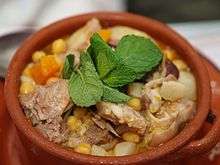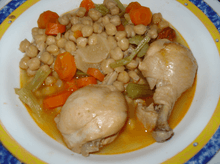Cocido
 Portuguese cozido de grão (chickpea cozido) | |
| Type | Stew |
|---|---|
| Place of origin | Portugal |
| Variations | Cozido à portuguesa |
Cocido (Peninsular Spanish: [koˈθiðo], Latin American Spanish: [koˈsiðo]) or cozido (European Portuguese: [kuˈzidu], Brazilian Portuguese: [koˈzidʊ]) is a traditional stew eaten as a main dish in Spain, Portugal, Brazil and other Hispanophone and Lusophone countries.[1][2]
Etymology
In Spanish, cocido is the past participle of the verb cocer (to cook), so cocido literally means "cooked [thing]."
In Portuguese, the word cozido means "cooked" ,"boiled", or "baked", being the past participle of the verb cozer ("to cook", "to boil", or "to bake").[3] Spanish cocido is a cognate.
Preparation and ingredients
Cocido is made of various meats (pork, beef, chicken, mutton), embutidos and vegetables like cabbage, turnips, parsnips, potatoes, carrots and chickpeas (garbanzos.) Other foods (such as eggs) can be added before serving. Due to the wide regional diversity of the dish, the word cocido is typically followed by the place of origin (e.g. madrileño, maragato, lebaniego, gallego).
The basic method of preparation involves slow cooking over a low heat. Cozido may be prepared with a wide variety of vegetables, meats, fish, and seafood.[4] Ingredients vary across regions.
Spanish cocido

Cocido makes for a complete meal as it contains all the necessary components of a nutritious diet. In the past, it was a popular dish among laborers whose jobs involved significant physical exertion. It was eaten primarily during the winter, helping people who lived in homes with inadequate heating maintain their body heat. So, the vegetables used in cocido are typically winter vegetables like turnips, carrots, and cabbage. However, as vegetables are now available year-round, other vegetables may be substituted.
One commonality among all the regional variants is that the cocido is served in multiple courses in the same meal. The first course is usually a soup, followed by a second course of the beans and potatoes used in the soup, with the meat and vegetables from the soup as the third course. Each course is known as a vuelco (overturn) because the pot is turned over every time to empty out the ingredients. Recently, it has become popular in some areas to end with a plate of huevos estrellados.
Some ancient recipes (generally from convents) call for cocidos of up to fourteen courses, using an elaborate selection of ingredients.
Although the cocido madrileño is most famous, many other types exist, such as cocido lebaniego and cocido montañés.
During the 19th century, cocido was a common dish for servants in the homes of the wealthy. Often, too much would be made, and the excess would be given to the poor. Alternatively, the leftovers were tossed with eggs to be served for dinner or the next day, giving rise to the dish ropa vieja as well as arroz al horno and arroz con costra in Valencian cuisine.
Portuguese cozido
Cozido à portuguesa
In Portugal, cozido à portuguesa is prepared with several vegetables (beans, potatoes, carrots, turnips, cabbages, rice), meat (chicken, pork ribs, bacon, pork ear and trotters, various parts of beef), smoked sausages (chouriço, farinheira, morcela, blood sausage), and other ingredients.[5][6] Numerous regional variations exist throughout Portugal, and the dish is considered part of the Portuguese heritage.
It is a rich stew that usually includes beef shin, pork, assorted offal, Portuguese smoked sausages (morcela, farinheira and chouriço) and in some regions chicken, served with cabbage, carrots, turnips, rice, potatoes, and collard greens. It is often served with olive oil and red wine.
Cozido de grão
Cozido de grão is prepared with chickpeas as the main ingredient.
Cozido das Furnas
In São Miguel Island, Açores, meaty cozido known as cozido das Furnas is cooked underground for four to five hours, with the natural heat from the volcanic activities.[7][8]
Brazilian cozido
In Brazil, potatoes, sweet potatoes, carrots, and cassava are commonly used.[9] Bananas can also be included in Brazilian cozido dishes.[10]
See also
References
- ↑ "cozido". Infopédia (in Portuguese). Porto Editora. Retrieved 3 April 2017.
- ↑ "cozido". Dicionário Michaelis (in Portuguese). Editora Melhoramentos. Retrieved 3 April 2017.
- ↑ "cozer". Infopédia (in Portuguese). Porto Editora. Retrieved 3 April 2017.
- ↑ Holland, Mina (2015) [2014]. The World on a Plate: 40 Cuisines, 100 Recipes, and the Stories Behind Them. New York: Penguin Books. p. 78. ISBN 9780143127659.
- ↑ Silva, Claudio (17 August 2016). "20 Things to Know Before You Go to Luanda". Roads & Kingdoms. Retrieved 23 March 2017.
- ↑ Saxelby, Ruth (10 August 2016). "FADER Mix: DJ Marfox". The Fader. Retrieved 23 March 2017.
- ↑ Andrade, Carina (20 March 2017). "Açores: eleito destino de 2017 para ingleses". Flash! (in Portuguese). ISSN 1647-2519. Retrieved 3 April 2017.
- ↑ Segalov, Michael (16 December 2016). "This Underground Stew Cooks Using Volcanic Heat". Munchies. VICE. Retrieved 3 April 2017.
- ↑ Palmerlee, Danny; Armstrong, Kate; Bao, Sandra; Benson, Sara; Brash, Celeste; Green, Molly; Kohn, Michael; Kohnstamm, Thomas; McCarthy, Carolyn; St Louis, Regis; Vidgen, Lucas (2013). South America on a shoestring (12 ed.). Lonely Planet. p. 402. ISBN 9781741798944.
- ↑ Fodor's Brazil (2nd ed.). New York: Fodor's. 2002. p. 58. ISBN 9780676901917.